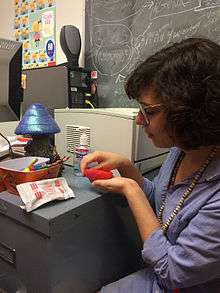Library makerspace
A library makerspace is an area and/or service that offers library patrons an opportunity to create intellectual and physical materials using resources such as computers, 3-D printers, audio and video capture and editing tools, and traditional arts and crafts supplies. In the field of library science, makerspaces are classified as a type of library service offered by librarians to patrons.

Definition
In a library makerspace or maker program, patrons of varying ages can work together, alone, or with library staff on creative projects. These spaces often give community members access to tools, technology, and social connections that may not be easily accessible otherwise. The goal of a makerspace is to allow patrons to learn through direct experimentation and from each other.[1] Library makerspaces do not require specified areas; a pre-existing space can be temporarily modified (or "made") to better suit the needs of participants. It is more about the intentions of the makers than about the qualities of the space itself.[2]
History
Beginning around 2006, the "maker movement" grew out of DIY culture. Libraries took notice and began offering programs and redesigning spaces to address related interests within their communities. The first public library with a maker space was the Fayetteville Free Library.[3]
Purposes
A library makerspace is intended to allow community members to experience technology or activities that they previously were not able to access. As many maker spaces include technology like 3D printers, sewing machines, soldering guns, coding, robotics, and wood carving machines, patrons are invited to experiment freely. The purpose of a maker space is often expressed to be inspiring an interest in science, technology, design, and life-long learning in the people who are served by the library.[4] Over time, it is expected that the available activities within each individual maker space will grow to reflect the interests of each community in which the library is housed.[5] Makerspaces are also intended to allow minorities or underrepresented populations, like women,[4] or people with disabilities,[6] to become involved with technology and fields they may not have previously considered.[4]
Types of activities and technology
There are many types of makerspaces offered as a library service. They are usually developed around a certain type of medium, technology, or even patron age group. Some examples include computer programming and coding, 3D modeling and printing, games, and traditional arts and crafts. Although experts in the area may be available, the community atmosphere of the space allows patrons to learn from each other and experiment rather than receive lessons.[7]
Maker spaces have also grown to allow patrons to take classes to develop a certain skill, like cooking, sewing or yoga.[8]
List of library makerspaces
United States
Public libraries:
- 4th Floor at Chattanooga Public Library
- Allen County Public Library Maker Labs
- Beaufort County Library Creation Station
- Black & Veatch MakerSpace at Johnson County Library
- Broward County Library Creation Station
- The Bubbler at Madison Public Library
- Fayetteville Free Library Creation Lab, Fab Lab, and Little Makerspace
- The Labs at Carnegie Library of Pittsburgh
- Cincinnati Library MakerSpace
- Chicago Public Library Maker Lab
- TechCentral MakerSpace at Cleveland Public Library
- CreateSpace at Middletown Free Library
- Creativity Lab at Peabody Institute Library
- Duxbury Free Library Makerspace
- ideaLAB at Denver Public Library
- Jocelyn H. Lee Innovation Lab at Harris County Public Library
- HATCH at Watertown Free Public Library
- The Hive at John F. Germany Public Library
- The Labs at DC Public Library
- The Maker Spot at the North Richland Hills Library
- MACH1 at Phoenix Public Library
- Make It at the Library (Idaho)
- medialab at Lomira QuadGraphics Community Library
- MILL Studio at Loudoun County Public Library
- Morse Institute Library Innovation Studio
- Pikes Peak Library District's Make & Make II
- Richland Library Teen Center
- Seminole Community Library Innovation Lab
- Skokie Public Library Digital Media Labs
- The Studio at Anythink (Rangeview) Libraries
- The Studio at Winnetka Library
- Digital Media Lab Highland Park Public Library
- Westport Public Library MakerSpace
- Urbana Free Library Teen Open Lab
Criticism
One criticism of maker spaces for libraries is that they may attract a specific demographic, e.g., the tech-savvy, while failing to welcome others from the community. Some librarians feel that the library should not be a place for manufacturing, and some contend that over-emphasis on high-tech equipment such as 3D printers is not in the true spirit of the maker movement. Implementing a library makerspace may be costly in the setup phase, and as some tools and equipment can have associated hazards, there is the issue of liability to consider.[9]
See also
References
- ↑ Moorefield-Land, Heather Michele. Makers in the Library: case studies of 3d printers and maker spaces in library settings, Library Hi Tech, 2014.
- ↑ "From Stacks to Hacks: Makerspaces and LibraryBox". Metropolitan New York Library Council. Metropolitan New York Library Council. Retrieved 1 April 2015.
- ↑ Clark, Melody. "Libraries & makerspaces: A revolution?". Technology and Social Change Group. University of Washington. Retrieved 1 April 2015.
- 1 2 3 Britton, Nicole and Ward, Michael. The Makings of Maker, Library Journal, 2012
- ↑ Britton, Nicole and Ward, Michael. The Makings of Maker, Library Journal, 2012.
- ↑ Tara Brady, Camille Salas, Ayah Nuriddin, Walter Rodgers & Mega Subramaniam (2014) MakeAbility: Creating Accessible Makerspace Events in a Public Library, Public Library Quarterly, 33:4, 330-347, DOI: 10.1080/01616846.2014.970425
- ↑ 7 things you should now about Maker spaces, Edacuse, 2013
- ↑ Dixon, Nicole and Ward, Michael. The Maker Movement and the Louisville Free Public Library, Accidental Press, 2014.
- ↑ Diane Slatter & Zaana Howard (2013) A place to make, hack, and learn: makerspaces in Australian public libraries, The Australian Library Journal, 62:4, 272-284, DOI:10.1080/00049670.2013.853335